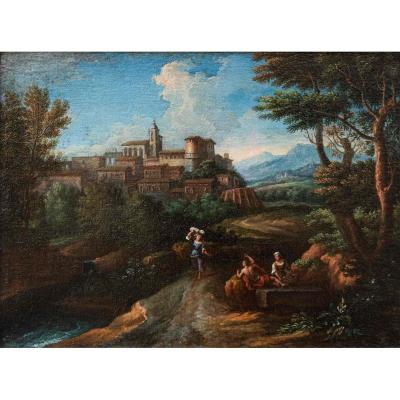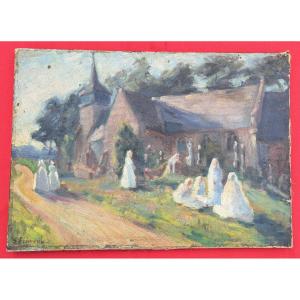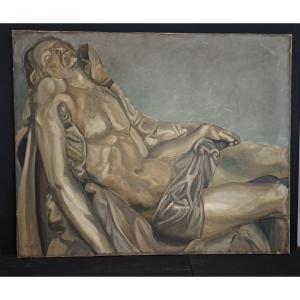Bust of Christ in prayer
Oil on canvas, cm 47 x 37,5
The compositional language and the use of a rich and precious chromy, from the bright red of the robe to the brilliant blue of the mantle and the lumeggiature of the hair strands, but also the dramatic use of light, true protagonist of the scene, They link the present painting to a painter of Cremona school well aware of the works of the Campi brothers, great innovators of sacred art in Lombardy of the second half of the 16th century. In particular, great ties are intertwined with the figure of Antonio Campi if we consider the painting of the same subject exhibited at the XIX Biennale dell'Antiquariato (2015) in Florence. The same attitude is also found in the San Jerónimo of the Prado Museum, where the saints with their hands bent over their hearts in a superplastic gesture look at the crucifix and the divine appearance, exemplified by the light coming from the right.
The episode of Christ praying intensely to God is a very dear theme to the Campi brothers who will repeat the episode of prayer in the garden of Gethsemane several times as in the sample of Santa Maria della Noce di Inverigo by Antonio or the Diocesan Museum of Pelplinie in Poland, work of Vincenzo and Antonio, in which our attention is calamitato by the face, in deep meditation and concentration but also anguished agony for the approaching death. In the present painting all superfluous elements are eliminated to focus on the face of Christ, the eyes to the sky rapt by the light source and the hand to the chest the mouth just opened can express a powerful sense meditation and prayer, Here Christ does not seem to suffer physically the pain of agony, but is meditating intensely on the destiny that awaits him in a key of redemption and redemption, even knowing that he will meet death.
The Campi brothers, Giulio, Antonio and Vincenzo Campi were among the most famous painters active in Lombardy of the sixteenth century. Painters in great demand, both by religious and lay clients, the three started a real family workshop in Cremona, their hometown, but whose activity reached as far as Milan and Spain. Cremona was characterized, throughout the course of the sixteenth century, by a fervent and prolific artistic environment. The border position allowed the local culture to open up towards the Venetian, Emilian, Milanese and Mantovano influences. This characteristic was reflected in the numerous artistic commissions, favoring the proliferation of the activity of "foreigner" artists such as Romanino and Pordenone. Equally fundamental for the development of artistic culture in Cremona were the relations with northern Europe (especially with the Flemish environment in the first decades of the sixteenth century).
In this lively cultural environment the workshop of the Campi family developed. The founder was Galeazzo, father of the three brothers and also active as a painter in Cremona. He had little influence on the style of his children, so much so that the real initiator of the school can be identified in the figure of his first-born son, Giulio. He also played the fundamental role of guide for the start of the activity of two younger brothers Antonio and Vincenzo. The artistic production of the family was requested by many clients, for the ability to make its own innovations of those years while maintaining their distinctive character. The workshop of the Campi brothers was distinguished in the city environment also for the training of several students (one of the best known was Lattanzio Gambara).
The artistic production of the three brothers is characterized by a certain stylistic commonality, under the guidance of the eldest of the three, Giulio. At the same time, it is undoubtedly to be recognized the ability of Antonio, and even more so of Vincenzo, to have taken his own personal path. If for some works still today the doubt remains on who is the author among the three, we witness a progressive transition, from major to minor, from an art more than fashion to a greater search of naturalism.
Among the fundamental works are the frescoes made by Giulio and Antonio church of San Sigismondo in Cremona, made from 1554 frescoes that suffer from the influence of Giulio Romano on the art of Giulio.
These are the years when the art of Antonio Campi is very close to that of his older brother and the collaborations between the two are very strict as shown by the frescoed rooms in Palazzo Barbò in Torre Pallavicina (BG) and Palazzo Maggi in Cadignano.Around the sixties of the century, the three brothers were on the Milanese art scene; here they participated, in 1564, to the competition for the realization of the organ doors of the Cathedral, their candidacy was supported by the archbishop Carlo Borromeo, Great admirer of their painting. It is from the seventies of the century that Antonio detaches himself from the fraternal figure to embrace a more personal style appreciated by the Milanese client among the most famous works such as the famous Crucifixion with episodes of the Passion of Christ of 1569 ( of which he made a replica for Carlo Borromeo) and the Decollazione del Battista of 1571 and the Martirio di San Lorenzo of 1581, both realized for the church of San Paolo Converso. In these paintings, a greater attention to naturalistic rendering emerges, certainly following studies of models from the real world, also for the luministic effects.
The object is in good condition


































 Le Magazine de PROANTIC
Le Magazine de PROANTIC TRÉSORS Magazine
TRÉSORS Magazine Rivista Artiquariato
Rivista Artiquariato